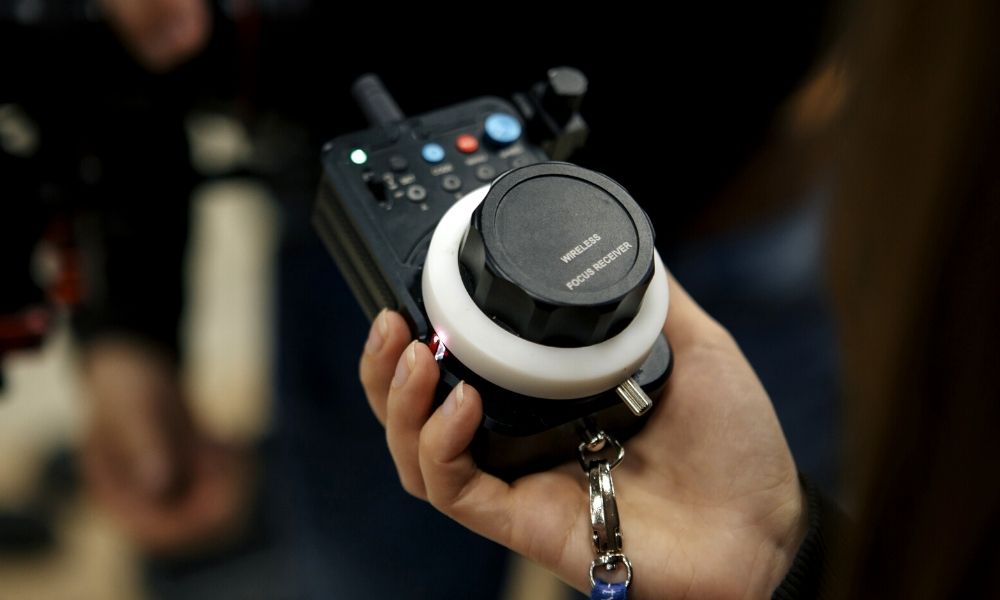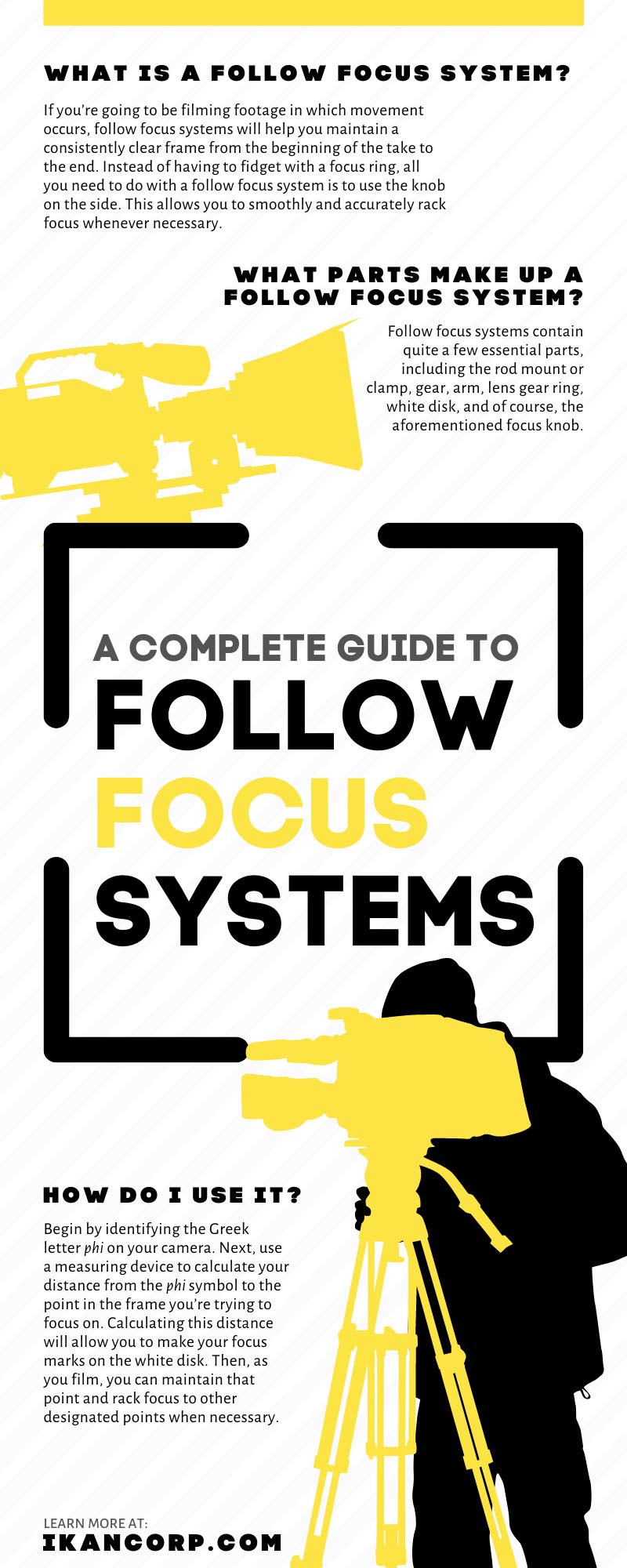
Even if an image is just slightly out of focus, it can become a distraction to the audience. In some cases, autofocus or turning the camera’s focus ring by hand will work. However, if you’re working on professional productions, then you need to have a follow focus system on your camera. To help you understand what this device is and how it works, we’ve put together a complete guide to follow focus systems.
What Is a Follow Focus System?
If you’re going to be filming footage in which movement occurs, follow focus systems will help you maintain a consistently clear frame from the beginning of the take to the end. Instead of having to fidget with a focus ring, all you need to do with a follow focus system is to use the knob on the side. This allows you to smoothly and accurately rack focus whenever necessary. Next, we’ll take you through the specific components of a traditional follow focus system.
What Parts Make up a Follow Focus System?
Follow focus systems contain quite a few essential parts, including the rod mount or clamp, gear, arm, lens gear ring, white disk, and of course, the aforementioned focus knob.
Rod Clamp/Mount
The rod clamp is essentially the base for your follow focus system. Attach it to the two rods at the base of the camera rig, hence the name “rod clamp.” Your rods will either be 15mm with spacing distances of 60mm or 100mm, or they’ll be 19mm with 104mm of space between them.
Arm
The arm attaches directly onto the rod clamp. You can choose a system that features a rigid arm or a more versatile arm. It should go without saying that going for the most flexible type of system is key. A versatile system allows you to work with a wider range of lenses than a rigid system would. Specifically, try to find an arm that allows for pivoting.
Gear
The gear attaches to the arm and essentially acts as the middleman between the lens knob and the camera focus. The knob uses the gear teeth to achieve a specific “throw,” which is how many degrees the focus ring needs to travel in order to go from its minimum focusing distance to its maximum.
One-to-one gears allow the focus ring and the focus knob to have the same throw, but not all productions are equal, so you might need something with a different level of throw. A short throw means that a large turn of the focus knob results in a small turn of the focus ring. On the other hand, a large throw means that a small turn of the focus knob results in a larger turn of the focus ring. Make sure the follow focus system you choose can provide you with the right throw capabilities.
Lens Gear Ring
This attaches to the gear and the lens ring, allowing full control of the camera’s focus. Some cameras already have teeth on the focus ring, making the lens gear ring unnecessary. If your camera does not have teeth, then it’s time to give them some with the help of one of these rings.
Focus Knob
In order to get that ring turning, you’ll need the focus knob. This is the component that allows you to change focus with easy, comfortable motions. Not only does the knob make racking more convenient for the focus puller, but it also allows for adjustments without crowding around the camera while the operator is trying to do his or her job.
White Disk
The white disk is the area in which you can write focus marks to ensure you’re getting the right clarity in accordance with the action taking place in front of the lens. If you have a good white disk, then you should be able to write down directions and erase them with no trouble at all, as long as you’re using a good dry-erase marker. That way, you can write down focus marks each time without worrying about them getting smeared.
Additional Gear
These pieces of gear don’t always come with a follow focus system, but they can be beneficial to your production if you make the effort to obtain them.
Focus Whip
This is an extension of the focus knob that allows you to adjust focus at a distance. Attaching a focus whip onto the knob provides the focus puller with the means to rack focus without disrupting the camera operator.
Wireless Follow Focus
To provide even more distance between the focus puller and the camera, use a wireless follow focus system. As the name suggests, these systems allow you to rack focus with a wireless device, so you no longer have to worry about getting in the camera operator’s way.
Speed Crank
This is another knob attachment but unlike the focus whip, as the name suggests, this attachment is more about efficiency than distance. Attaching this to the camera allows you to rack focus at quicker speeds when necessary.
How Do I Use It?
Begin by identifying the Greek letter phi on your camera. Next, use a measuring device to calculate your distance from the phi symbol to the point in the frame you’re trying to focus on.
There are varied tools you can use to measure this distance, but how you do so depends on how far away your subject is. If your subject is 25 or fewer feet away from you, a simple measuring tape will suffice. If your subject stands somewhere between 25 and 300 feet away, you’ll have to use a fiberglass measuring tape instead.
To retain versatile shooting capabilities, carry one 50-feet fiberglass measuring tape, as well as one 300-foot fiberglass measuring tape at all times. You won’t always need the 300-foot tape, but it’s smart to have one in your equipment arsenal just in case.
Focusing on subjects that are more than 300 feet away will require the use of a laser rangefinder. When using a laser, don’t point it at the camera or any other humans nearby. It should go without saying, but safety always needs to be a top priority on set.
Calculating this distance will allow you to make your focus marks on the white disk. Then, as you film, you can maintain that point and rack focus to other designated points when necessary. If you’re going to be racking focus between two or more points, we recommend labeling each mark with a 1, 2, and so on, to avoid making the wrong adjustments while filming.
Now that you have a complete guide to follow focus systems, you should know whether or not they’re a good fit for your production needs. If you decide that they are, this guide will also help you find a system with the right specifications to fit your specific requirements. At Ikan, we can outfit your production with a wired, wireless, or mechanical follow focus system for your next shoot. That way, the next time you’re on set, you’ll have total control of the image clarity instead of falling victim to poor focus quality.

